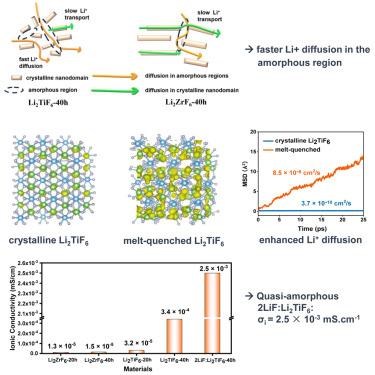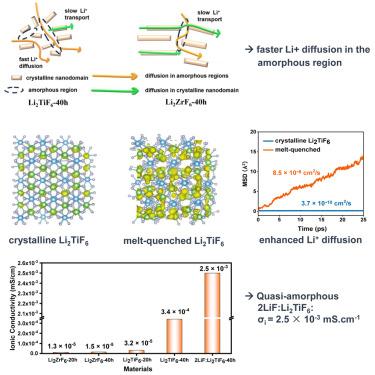Unlocking lithium ion conduction in lithium metal fluorides
IF 17.5
1区 材料科学
Q1 MATERIALS SCIENCE, MULTIDISCIPLINARY
引用次数: 0
Abstract
Here, we demonstrate that quasi-crystalline lithium metal fluoride materials prepared by mechanochemical synthesis exhibit up to 300-fold higher ionic conductivity than their crystalline counterparts, with Li2TiF6 being the example in point. By probing the “amorphous” and crystalline forms of these materials at different length scales, we show that the introduction of structural disorder at short to long length scales is crucial for facilitating Li+ transport. Moreover, we show that the addition of LiF creates an interaction with Li2TiF6 at the local level that readily disrupts the long-range order. The ionic conductivity of the composite material reaches a benchmark value of 2.5 × 10−3 mS cm−1, the highest of fluoride materials reported in the literature and on par with LiPON and LiNbO3. This work delivers insights into structure-conductivity relationships contrasting crystalline and amorphous materials and shows strategies to unlock ion conduction.


揭开金属锂氟化物中锂离子传导的神秘面纱
在这里,我们证明了通过机械化学合成法制备的准晶体金属氟化锂材料的离子电导率比晶体材料高出 300 倍,Li2TiF6 就是一个很好的例子。通过探测这些材料在不同长度尺度上的 "无定形 "和晶体形态,我们发现在短到长的长度尺度上引入结构无序对促进 Li+ 传输至关重要。此外,我们还表明,LiF 的加入会在局部与 Li2TiF6 产生相互作用,从而轻易地破坏长程有序性。复合材料的离子电导率达到了 2.5 × 10-3 mS cm-1 的基准值,是文献报道的氟化物材料中最高的,与 LiPON 和 LiNbO3 不相上下。这项研究深入揭示了晶体材料与非晶体材料之间的结构-传导关系,并展示了释放离子传导的策略。
本文章由计算机程序翻译,如有差异,请以英文原文为准。
求助全文
约1分钟内获得全文
求助全文
来源期刊

Matter
MATERIALS SCIENCE, MULTIDISCIPLINARY-
CiteScore
26.30
自引率
2.60%
发文量
367
期刊介绍:
Matter, a monthly journal affiliated with Cell, spans the broad field of materials science from nano to macro levels,covering fundamentals to applications. Embracing groundbreaking technologies,it includes full-length research articles,reviews, perspectives,previews, opinions, personnel stories, and general editorial content.
Matter aims to be the primary resource for researchers in academia and industry, inspiring the next generation of materials scientists.
 求助内容:
求助内容: 应助结果提醒方式:
应助结果提醒方式:


